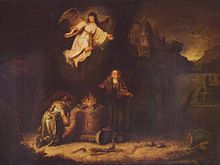Govaert Flinck

Govert (also Govaert) Flinck (born January 25, 1615 in Kleve , † February 2, 1660 in Amsterdam ) was a Dutch genre, history and portrait painter and draftsman.
Life
Flinck was the son of Thonis Flinck, a bleacher or textile merchant. His mother, unknown by name, was the daughter of the Cologne-based Mennonite preacher and painter Ameldonck Leeuw. He was one of the co-signers of the Concept van Keulen , "a contract that defines a number of basic principles in which Frisian , Waterlandse and German Mennonite communities had come together."
In 1629 Flinck received his first lessons from Lambert Jacobsz. in Leeuwarden . Around 1632 he went to Amsterdam , where he received drawing and painting lessons from Rembrandt van Rijn until 1635 and worked for Hendrick van Uylenburgh . His style he appropriated greatly, so that among all of Rembrandt's students, with the exception of Eeckhout , his pictures are most similar to those of the master. Then he started his independent work.
plant
Flinck was a highly respected artist even during his lifetime. His portraits were widely recognized by the Amsterdam bourgeoisie and at the royal court. Elector Friedrich Wilhelm von Brandenburg and Prince Moritz von Nassau had him painted many pictures, preferably portraits. In 1652 he received citizenship in Amsterdam.
He painted histories: Isaac blesses Jacob (1638, in the Rijksmuseum Amsterdam ), Abraham, repudiation of Hagar (in Berlin), the angel, proclaiming the birth of Christ to the shepherds (in the Louvre in Paris etc.), also genre pictures, such as the guard room (in Munich). His main activity, however, extended to portrait painting.
At the age of 22 he already achieved something special, as the portrait of a young man in the Hermitage in St. Petersburg shows. He shows himself at the full height of the championship in the Regentenstück from 1642 (in the Amsterdam City Hall ). Also outstanding are the large shooting piece and his painting with the peace celebration on the occasion of the Peace of Westphalia , both from 1648 and in the Rijksmuseum Amsterdam. Govert Flinck enjoyed the friendship of the brothers Cornelis and Andries de Graeff and the Six family . During the reign of the De Graeff family , Flinck received many public commissions and honors. So he created some biblical scenes for the Amsterdam City Hall. Flinck also received portraits from the House of Orange and from Margrave Friedrich Wilhelm von Brandenburg .
Stylistically, his paintings are initially very similar to those of Rembrandt, as the illustrations show. Around 1642, probably under the impression of the success of Flemish painting by Anthonis van Dyck and Peter Paul Rubens , he brushed off the influence of his master. His palette brightens and becomes more multicolored, which makes his pictures look more cheerful and pleasing.
Like Rembrandt , Flinck was also a passionate collector of plaster casts based on ancient sculptures, paintings, hand drawings and copperplate engravings, for which 12,000 guilders were paid for after his death . His son Nicolaes Anthoni Flinck also owned a rich collection which passed to the Duke of Devonshire after his death.
Selection of works
- Die Kloveniererschützen, 1642, canvas, 203 × 278 cm. Rijksmuseum Amsterdam .
- Peace celebration , 1648, canvas, 265 × 513 cm. Amsterdam, Rijksmuseum.
- Solomon's Prayer, 1658, canvas, approx. 300 × 200 cm. Amsterdam, Koninklijk Paleis .
- Golgotha, 1649, wood, 119 × 90 cm. Basel, art museum.
- Isaac blesses Jacob, canvas, 117 × 141 cm. Amsterdam, Rijksmuseum.
- Samuel Manasse Ben Israel (oval), 1637, wood, 75 × 59 cm. The Hague , Mauritshuis .
- Annunciation to the Shepherds, 1639, canvas, 155 × 196 cm. Paris, Musee National du Louvre .
- Old Man, 1651, canvas, 99.5 × 84 cm. Vienna , Art History Museum .
- Portrait of the Great Elector Margrave Friedrich Wilhelm of Brandenburg , 1652, canvas.
- Portrait of Cornelis Bicker , 1654, canvas, Amsterdams Historisch Museum .
- Portrait of Margaretha Tulp as a bride, 1655, canvas, 138 × 104 cm, Wilhelmshöhe Palace , Kassel .
- Sleeping Cupid, purchased in 1986, Caputh near Potsdam, Caputh Castle .
- Susanna and the two elders around 1640, Berlin Gemäldegalerie .
literature
- Carl von Lemcke: Flinck, Govert . In: Allgemeine Deutsche Biographie (ADB). Volume 7, Duncker & Humblot, Leipzig 1877, p. 122 f.
Web links
- Literature by and about Govaert Flinck in the catalog of the German National Library
- Getty Museum Biography (English)
- Exhibition "Govert Flinck - Reflecting History", October 4th, 2015 - January 17th, 2016 in Kleve
Individual evidence
- ↑ Tom van der Molen: The life of Govert Flinck . In: Govert Flinck. Reflecting History . Museum Kurhaus Kleve - Ewald Mataré Collection, BOSS - Printing and Media, Goch 2015, ISBN 978-3-934935-75-4 , p. 11.
| personal data | |
|---|---|
| SURNAME | Flinck, Govaert |
| ALTERNATIVE NAMES | Flinck, Govert |
| BRIEF DESCRIPTION | Dutch genre, history and portrait painter and draftsman |
| DATE OF BIRTH | January 25, 1615 |
| PLACE OF BIRTH | Kleve |
| DATE OF DEATH | February 2, 1660 |
| Place of death | Amsterdam |



